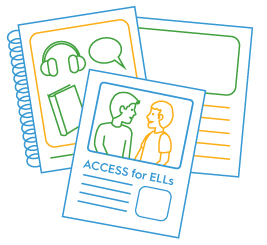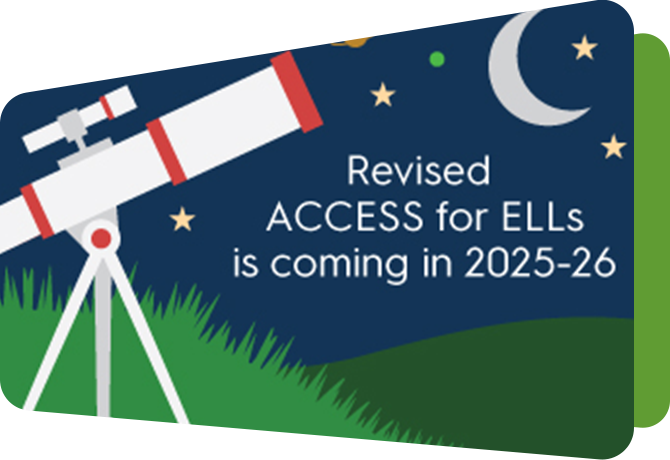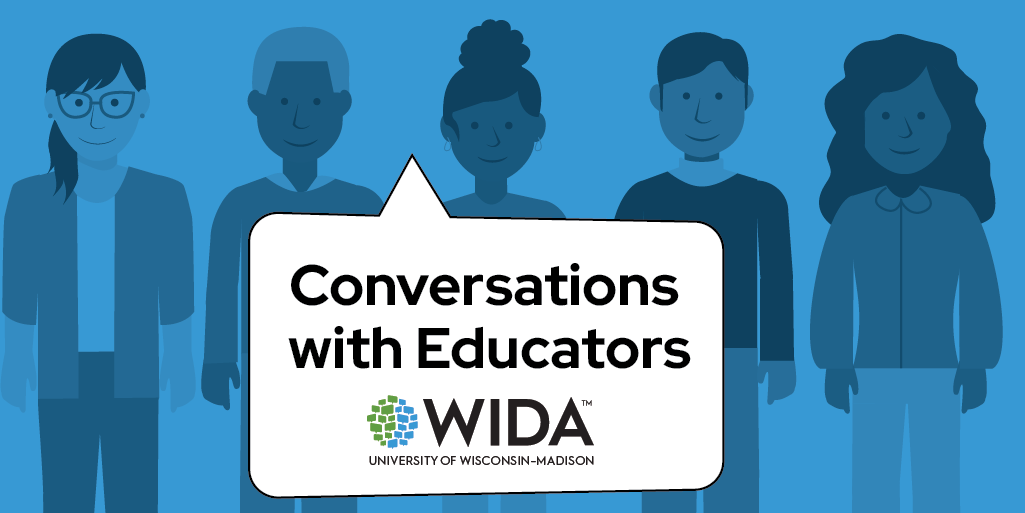Resources/Recursos
Featured Resources



All resources/Todos los recursos
Filter resources by:
Resources/Recursos
WIDA Alternate Screener Participation Decision Tree
This guide helps IEP teams determine if a student should take the WIDA Alternate Screener assessment, or the WIDA Screener (Kindergarten, Online or Paper) assessment with accommodations.
Resource Details View Download NowReleased June 2025
What is WIDA Screener? (multiple languages)
Use this handout in intake centers or at parent-teacher conferences to help explain what WIDA Screener is and the process of screening students and identifying them as English learners. This family handout, available in multiple languages, includes a section for families to take notes and ask questions about English language services.
Note: This handout replaces the Explaining ELL Status and What Is Language Testing? flyers, which were retired July 1, 2025.
Resource DetailsReleased June 2025
What Is WIDA Alternate Screener? (multiple languages)
Use this handout in intake centers or at parent-teacher conferences to help explain what WIDA Alternate Screener is and the process of screening students with the most significant cognitive disabilities and identifying them as English learners. This family handout, available in multiple languages, includes a section for families to take notes and ask questions about English language services.
Resource DetailsReleased June 2025
Individual Characteristics Questionnaire
Individual Characteristics Questionnaire (ICQ), which is part of WIDA Alternate ACCESS, captures characteristics of students who take Alternate ACCESS. Test Administrators will fill out the ICQ for each student and that information will be reported on the Individual Student Report. ICQ information can help educator teams make program decisions for students. Prior to administering Alternate ACCESS, download and print this example ICQ and use it to consult with Individual Education Plan (IEP) team members about students. Final responses will be entered on the Student Response Booklet.
Resource Details View Download NowReleased June 2025
Aligning AI for Multilingual Learners: Integrating the WIDA Standards Framework into Prompts
This webinar explored how to use artificial intelligence (AI) effectively to create engaging and standards-based activities for multilingual learners. It focused on techniques to avoid generic results and tailor AI prompts to the specific needs of multilingual learners, aligned with the WIDA English Language Development (ELD) Standards Framework. This webinar was designed to be interactive, with opportunities to crowd-source examples for using AI effectively to promote content-based language learning for multilingual students.
Resource DetailsReleased June 2025
Annual Technical Report for WIDA Alternate ACCESS English Language Proficiency Test, Series 602, 2023-2024 (redacted version)
WIDA Alternate ACCESS technical reports provide evidence for validity and reliability of Alternate ACCESS and support intended uses, interpretations and decisions made with the test.
This is the redacted report for the 2023-2024 administration of Alternate ACCESS. Item information is removed from the report.
Resource Details View Download NowReleased June 2025
The Marco ALE de WIDA: A sociocultural approach to the creation of Spanish language arts standards
This WIDA Snapshot introduces the Marco de referencia de las artes del lenguaje del español de WIDA: Aplicación para la actualización y desarrollo de estándares (Marco ALE). The Marco ALE is a Spanish language arts framework and is designed to support the development of Spanish language arts standards specifically for educational settings in the United States.
Resource DetailsReleased May 2025
Tell Us About Your Child Survey
The Tell Us About Your Child Survey is a questionnaire that educators can give to families or caregivers of multilingual learners with the most significant cognitive disabilities to better understand a student's language and communication needs. In the survey, families or caregivers will answer questions about a student’s method of communication and language, their ability to understand communication and their preferred communication supports.
Resource DetailsReleased May 2025
WIDA Speaking Scoring Scale Grades 1-12
Use this scoring scale to score speaking responses for WIDA Screener tests and the WIDA ACCESS Braille Speaking test only.
Note: To score WIDA ACCESS tests, refer to the WIDA Speaking Scoring Rubric Grades 1–12.
Resource Details View Download NowReleased May 2025
WIDA Writing Scoring Scale Grades 1-12
Use this scoring scale to score writing responses for WIDA Screener tests only.
Note: To score writing responses for WIDA ACCESS tests, refer to the WIDA Writing Scoring Rubric Grades 1–12.
Resource Details View Download NowReleased May 2025
WIDA Speaking Rubric Kindergarten
Use this rubric to score speaking responses on WIDA Screener for Kindergarten and WIDA MODEL for Kindergarten only.
Resource Details View Download NowReleased May 2025
WIDA Writing Rubric Kindergarten
Use this rubric to score writing responses on WIDA Screener for Kindergarten and WIDA MODEL for Kindergarten only.
Resource Details View Download NowReleased May 2025
Strategies for Supporting Multilingual Newcomers
Multilingual newcomers are the fastest growing demographic across U.S. school systems, arriving in K-12 classrooms at increased rates in more and different locations than ever before. These students enter our buildings offering unique cultural and linguistic assets while also possessing distinct academic, social-emotional and linguistic needs. We met to discuss how we can build and strengthen systems that promote multilingual newcomers’ success in classrooms across the consortium! During this webinar, we talk about the latest trends relating to our nation's multilingual newcomers, engage in research-backed approaches centering their learning, and participate in goal setting for future programming with multilingual newcomers and their families in mind.
Resource DetailsReleased April 2025
WIDA MODEL Speaking Rubric Grades 1-12
Rubrics are analytic scales that describe various aspects of spoken and written language to help educators recognize what speaking and writing sound and look like at various levels of English language proficiency. Use the WIDA MODEL Speaking Rubric to understand the scores students earn on the assessment, analyze student performance in the classroom, and plan ways to scaffold language learning. WIDA MODEL test administrators use the WIDA MODEL Speaking Rubric to score the Speaking domain test for WIDA MODEL Online and WIDA MODEL Paper.
Resource Details View Download NowReleased April 2025
WIDA Alternate ACCESS Interpretive Guide for Score Reports
This guide provides a comprehensive explanation of the types of scores reported by Alternate ACCESS for students in grades K-12.
Resource Details View Download NowReleased March 2025
Pracademics: The Intersection of Teaching and Research
By addressing the intersection of practice and academia, teachers are encouraged to be more involved in implementing evidence-based approaches and becoming more familiar with research informing their classroom practice directly. Engaging in pracademics highlights the work of teacher experiences and promotes the inclusion of practitioners' voices in the field.
Resource DetailsReleased February 2025
Pracademics at the Intersection of Multilingualism, Translanguaging and Transculturalism
This research brief explores the intersection of pracademics, multilingualism, translanguaging and transculturalism. It highlights how pracademics’ unique dual expertise prepares them to face pressing, real-world challenges in the diverse education settings they encounter while addressing nuances of overlapping linguistic and cultural identities. Additionally, it presents diverse voices from the field, highlighting their thoughts on the topic and the impact that pracademics has on their contexts, professional lives and experiences.
Resource DetailsReleased February 2025
La Pracademia: La intersección entre multilingüismo, translenguaje y transculturalismo
Este resumen de investigación aborda la intersección entre la pracademia, el multilingüismo, el translingüismo y el transculturalismo. Destaca cómo la experiencia dual única de los pracadémicos les prepara para enfrentar los desafíos reales de diversos contextos educativos y examinar los matices de las identidades lingüísticas y culturales superpuestas. Además, presenta diversas voces del campo, destacando sus pensamientos sobre el tema y el impacto que la pracademia tiene en sus contextos, vidas profesionales y experiencias.
Resource DetailsReleased February 2025
WIDA MODEL Writing Rubric Grades 1-12
Rubrics are analytic scales that describe various aspects of spoken and written language to help educators recognize what speaking and writing sound and look like at various levels of English language proficiency. Use the WIDA MODEL Writing Rubric to understand the scores students earn on the assessment, analyze student performance in the classroom, and plan ways to scaffold language learning. WIDA MODEL test administrators use the WIDA MODEL Writing Rubric to assign a Writing Final score for WIDA MODEL Paper and WIDA MODEL Online.
Resource Details View Download NowReleased February 2025
Understanding the Proficiency Level Descriptors of Marco DALE
Los descriptores del desempeño lingüístico in Marco DALE provide guidance on how bi/multilingual students can develop language that they can interpret, interact and express in each of the communication modes (interpretative, interactive and expressive).
Resource DetailsReleased February 2025




